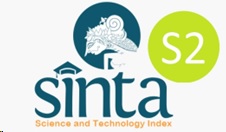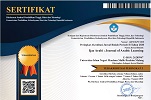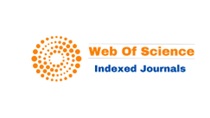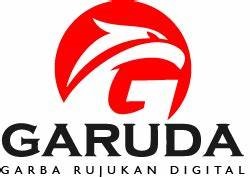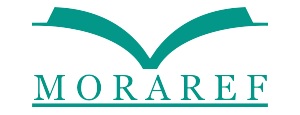Author Guidelines
General Organization of Paper (2023)
The paper will be published in Ijaz Arabi Journal Of Arabic Language after the peer-reviewed process and decided as “Accepted” by Editor.
Manuscript content should, in general, be organized in the following order: TITLE; AUTHORS NAME; AUTHORS AFFILIATION; ABSTRACT; KEYWORDS; INTRODUCTION; METHOD; RESULTS AND DISCUSSION; CONCLUSION; ACKNOWLEDGMENTS (optional); and REFERENCES. Please follow the template
Body Text
The body of the text is a set of body text paragraphs defined as follows:
- 12pt Times New Roman, for Arabic 16pt Sakkal Majalla
- One space, defined as 12pt
Paper Title
The title of the paper should be less then 20 words, in 14 pt bold Times New Roman and be centered. SHOULD HAVE ENGLISH TITLE and Roman script. The title should have 0 pts space above and 12 pts below.
Authors Name and Affiliations
Write Author(s) names without a title and professional positions such as Prof, Dr, Production Manager, etc. Do not abbreviate your last/family name. Always give your First and Last names. Write clear affiliation of all Authors. Since volume 7, affiliation includes a name of department/ college, university and country. Please indicate Corresponding Author (include email address) by adding an asterisk (*) in superscript behind the name.
Author names should be in 12 pt Times Roman bold. Authors addresses are superscripted by numerals and centered over both columns of manuscripts. Author affiliations should be in 12 pt Times Roman.
Abstract and Keywords
An abstract should stand alone, means that no citation in the abstract. Consider it the advertisement of your article. The abstract should tell the prospective reader what you did and highlight the key findings. Avoid using technical jargon and uncommon abbreviations. You must be accurate, brief, clear and specific. Use words which reflect the precise meaning. The abstract should be precise and honest. Please follow word limitations (100‐300 words).
Keywords are the labels of your manuscript and critical to correct indexing and searching. Therefore the keywords should represent the content and highlight of your article. Use only those abbreviations that are firmly established in the field. Each word/phrase in keyword should be separated by a semicolon (;).
INTRODUCTION
In Introduction, Authors should state the objectives of the work at the end of introduction section. Before the objective, Authors should provide an adequate background, and very short literature survey in order to record the existing solutions/method, to show which is the best of previous researches, to show the main limitation of the previous researches, to show what do you hope to achieve (to solve the limitation), and to show the scientific merit or novelties of the paper. Avoid a detailed literature survey or a summary of the results. Do not describe literature survey as author by author, but should be presented as group per method or topic reviewed which refers to some literatures.
Example of novelty statement or the gap analysis statement in the end of Introduction section (after state of the art of previous research survey): “........ (short summary of background)....... A few researchers focused on ....... There have been limited studies concerned on ........ Therefore, this research intends to ................. The objectives of this research are .........”.
METHOD
Methods should make readers be able to reproduce the experiment. Provide sufficient detail to allow the work to be reproduced. Methods already published should be indicated by a reference: only relevant modifications should be described. Do not repeat the details of established methods.
RESULTS AND DISCUSSION
Results should be clear and concise. The results should summarize (scientific) findings rather than providing data in great detail. Please highlight differences between your results or findings and the previous publications by other researchers. The discussion should explore the significance of the results of the work, not repeat them. A combined Results and Discussion section is often appropriate. Avoid extensive citations and discussion of published literature.
In discussion, it is the most important section of your article. Here you get the chance to sell your data. Make the discussion corresponding to the results, but do not reiterate the results. Often should begin with a brief summary of the main scientific findings (not experimental results).
The following components should be covered in discussion: How do your results relate to the original question or objectives outlined in the Introduction section (what/how)? Do you provide interpretation scientifically for each of your results or findings presented (why)? Are your results consistent with what other investigators have reported (what else)? Or are there any differences?
CONCLUSION
Conclusions should answer the objectives of the research. Tells how your work advances the field from the present state of knowledge. Without clear Conclusions, reviewers and readers will find it difficult to judge the work, and whether or not it merits publication in the journal. Do not repeat the Abstract, or just list experimental results. Provide a clear scientific justification for your work, and indicate possible applications and extensions. You should also suggest future experiments and/or point out those that are underway.
ACKNOWLEDGMENT
Recognize those who helped in the research, especially funding supporter of your research. Include individuals who have assisted you in your study: Advisors, Financial supporters, or may another supporter, i.e. Proofreaders, Typists, and Suppliers, who may have given materials. Do not acknowledge one of the authors names.
REFERENCES
The Citation and Reference listuses the APA 7th Style Edition (www.apastyle.org). Please use Reference Manager Applications like EndNote, Mendeley, Zotero, etc. Use other published articles in the same journal as models.
All publications cited in the text should be included as a list of references. This journal has to follow standard templates available in key reference management packages EndNote (http://www.endnote.com/support/enstyles.asp), Mendeley (https://www.mendeley.com). Using plug-ins to word processing packages, authors only need to select the appropriate journal template when preparing their article and the list of references and citations to these will be formatted according to the journal style, which is described below.
REFERENCES (Examples)
Angeli, E., Wagner, J., Lawrick, E., Moore, K., Anderson, M., Soderland, L., & amp; Brizee, A. (2010, May 5). General Format. Retrieved February 9, 2013, from http://owl.english.purdue.edu/owl/resource/560/01/.
Ball, S., Kenny, A., & Amp; Gardiner, D. (1990). Literacy, Politics And The Teaching Of English. In I. Goodson, & P. Medway, (Eds.), Bringing English To Order (pp. 47- 86). London: The Falmer Press.
Big Drop In Students Studying O-level Literature. (1997, August 16). The Straits Times, p. 3.
Chambers, E., & Gregory, M. (2006). Teaching And Learning English Literature. London: Sage Ltd.
Choo, S. (2004). Investigating Ideology In The Literature Curriculum In Singapore. Unpublished Master’s Thesis. Department Of English Language And Literature: National University Of Singapore.
Choo, S. (2011). On Literature’s Use(ful/less)ness: Reconceptualising The Literature Curriculum In The Age Of Globalisation. Journal Of Curriculum Studies, 43(1), 47-67.
Curriculum Planning And Development Division. (2007). Literature In English, Teaching Syllabus. Ministry Of Education: Singapore.
Before sending your paper, please perform typographical, grammatical error and plagiarism by using:
- Grammarly: www.grammarly.com
- Turnitin: http://turnitin.com
Contatc:
a. Website : http://ejournal.uin-malang.ac.id/index.php/ijazarabi
b. Email : ijazarabi@uin-malang.ac.id
Author Fees
We would like to inform you that starting June 2024 we will apply an Article Processing Charges (APCs) of USD 300 to cover the publication services, including the costs of peer review administration and management, and production of articles in PDF. The APC is payable when your manuscript is already accepted after pre-review process. All articles published in Ijaz Arabi Journal of Arabic Learning are freely available online and open access. We are looking forward to your contribution to the journal in the upcoming issues.
Please contact us:
Editor in Chief: Nuril Mufidah
WhatsApp: +628563 567 234
.png)





